The Economic Landscape of Global Rabies: A Scoping Review and Future Directions
Abstract
1. Introduction
2. Materials and Methods
3. Results
3.1. Timeline
3.2. Location and Research Institution
3.3. Species
3.4. Type of Analysis
4. Discussion
Supplementary Materials
Author Contributions
Funding
Data Availability Statement
Conflicts of Interest
Abbreviations
| DALYs | Disability-adjusted life years |
| WHO | Directory of open access journals |
| FAO | Food and Agriculture Organization |
| OIE | World Organization for Animal Health |
| GARC | Global Alliance for Rabies Control |
| PEP | Postexposure prophylaxis |
| PRISMA | Preferred Reporting Items for Systematic Reviews and Meta-Analyses |
| ScR | Scoping Review |
| CDC | Centers for Disease Control and Prevention |
| CBA | Cost–benefit analyses |
| CEA | Cost–effectiveness analysis |
Appendix A
| Database | Query | # of Results |
|---|---|---|
| Web of Science | TI = Rabies AND TI = Economic OR Financial OR Cost OR Bioeconomic | 115 |
| TI = Rabies AND AB = Dollar | 18 | |
| EBSCO Host | TI = Rabies AND TI = Economic OR Financial OR Cost OR Bioeconomic | 324 |
| TI = Rabies AND AB = Dollar | 42 | |
| PubMed | TI = Rabies AND TI = Economic OR Financial OR Cost OR Bioeconomic | 97 |
| TI = Rabies AND TIorAB = Dollar | 2 | |
| Scopus | TI = Rabies AND TI = Economic OR Financial OR Cost OR Bioeconomic | 125 |
| TI = Rabies AND AB/TI/KEYW = Dollar | 21 | |
| Total: | 744 |
References
- Tarantola, A. Four thousand years of concepts relating to rabies in animals and humans, its prevention and its cure. Trop. Med. Infect. Dis. 2017, 2, 5. [Google Scholar] [CrossRef] [PubMed]
- Hampson, K.; Coudeville, L.; Lembo, T.; Sambo, M.; Kieffer, A.; Attlan, M.; Barrat, J.; Blanton, J.D.; Briggs, D.J.; Cleaveland, S.; et al. Estimating the global burden of endemic canine rabies. PLoS Neglected Trop. Dis. 2015, 9, e0003709. [Google Scholar] [CrossRef]
- Anderson, A.; Shwiff, S.A. The cost of canine rabies on four continents. Transbound. Emerg. Dis. 2015, 62, 446–452. [Google Scholar] [CrossRef]
- Ma, X.; Monroe, B.P.; Cleaton, J.M.; Orciari, L.A.; Li, Y.; Kirby, J.D.; Blanton, J.D. Rabies Surveillance in the United States During 2017. J. Am. Vet. Med. Assoc. 2018, 253, 1555–1568. [Google Scholar] [CrossRef]
- Shwiff, S.; Hampson, K.; Anderson, A. Potential economic benefits of eliminating canine rabies. Antivir. Res. 2013, 98, 352–356. [Google Scholar] [CrossRef]
- World Health Organization. WHO Expert Consultation on Rabies: Second Report; World Health Organization: Geneva, Switzerland, 2013. [Google Scholar]
- Elmore, S.A.; Chipman, R.B.; Slate, D.; Huyvaert, K.P.; VerCauteren, K.C.; Gilbert, A.T. Management and modeling approaches for controlling raccoon rabies: The road to elimination. PLoS Neglected Trop. Dis. 2017, 11, e0005249. [Google Scholar] [CrossRef]
- Tiwari, H.K.; Gogoi-Tiwari, J.; Robertson, I.D. Eliminating dog-mediated rabies: Challenges and strategies. Anim. Dis. 2021, 1, 19. [Google Scholar] [CrossRef]
- VerCauteren, K.C.; Ellis, C.; Chipman, R.; DeLiberto, T.; Shwiff, S.; Slate, D. Rabies in North America: A model of the one health approach. In Proceedings of the 14th Wildlife Damage Management Conference, Nebraska, NE, USA, 18–21 April 2011; Frey, S.N., Ed.; pp. 56–63. [Google Scholar]
- World Health Organization. WHO Expert Consultation on Rabies: Third report; WHO Technical Series Report No. 1012; World Health Organization: Geneva, Switzerland, 2018. [Google Scholar]
- Meltzer, M.I.; Rupprecht, C.E. A review of the economics of the prevention and control of rabies: Part 2: Rabies in dogs, livestock and wildlife. Pharmacoeconomics 1998, 14, 481–498. [Google Scholar] [CrossRef]
- Jibat, T.; Hogeveen, H.; Mourits, M.C.M. Review on dog rabies vaccination coverage in Africa: A question of dog accessibility or cost recovery? PLoS Neglected Trop. Dis. 2015, 9, e0003447. [Google Scholar] [CrossRef] [PubMed]
- Shwiff, S.A.; Anderson, A.; Nadin-Davis, S. The health economics of rabies in the Americas: An historical summary and a synthesis of the literature. In History of Rabies in The Americas: From The Pre-Columbian to The Present; Rupprecht, C.E., Dykes, N.L., Childs, J.E., Eds.; Springer: Berlin/Heidelberg, Germany, 2023; Volume I, pp. 281–292. [Google Scholar]
- Tunas, I.K.; Putra, M.P.H.; Sutiasa, I.M.; Budayanti, N.N.S.; Antara, I.N.L.W.; Sudhana, I.B.P. Cost-effectiveness analysis of rabies control program, 2008–2017: A systematic review. J. Health Manag. 2023, 25, 966–973. [Google Scholar] [CrossRef]
- Anothaisintawee, T.; Genuino, A.J.; Thavorncharoensap, M.; Youngkong, S.; Rattanavipapong, W.; Meeyai, A.; Chaikledkaew, U. Cost-effectiveness modelling studies of all preventive measures against rabies: A systematic review. Vaccine 2019, 37, A146–A153. [Google Scholar] [CrossRef]
- Page, M.J.; McKenzie, J.E.; Bossuyt, P.M.; Boutron, I.; Hoffmann, T.C.; Mulrow, C.D.; Shamseer, L.; Tetzlaff, J.M.; Akl, E.A.; Brennan, S.E.; et al. The PRISMA 2020 Statement: An Updated Guideline for Reporting Systematic Reviews. BMJ 2021, 88, 105906. [Google Scholar] [CrossRef]
- Tricco, A.C.; Lillie, E.; Zarin, W.; O’Brien, K.K.; Colquhoun, H.; Levac, D.; Moher, D.; Peters, M.D.J.; Horsley, T.; Weeks, L.; et al. PRISMA Extension for Scoping Reviews (PRISMA-ScR): Checklist and Explanation. Ann. Intern. Med. 2018, 169, 467–473. [Google Scholar] [CrossRef] [PubMed]
- Zotero, version 6.0.26; Corporation for Digital Scholarship: Vienna, VA, USA, 2023. Available online: https://www.zotero.org/ (accessed on 23 July 2025).
- de Diego, A.I.; Valotta, J.R. Bat-Transmitted Rabies. Situation in Argentina; Sociedad de Medicina Veterinaria, Buenos Aires, Argentina, 1973; pp. 275–295.
- Noah, D.L.; Smith, M.G.; Gotthardt, J.C.; Krebs, J.W.; Green, D.; Childs, J.E. Mass human exposure to rabies in New Hampshire: Exposures, treatment, and cost. Am. J. Public Health 1996, 86, 1149–1151. [Google Scholar] [CrossRef] [PubMed][Green Version]
- Kiakalayeh, A.D.; Gharib, Z.; Mohammadi, R.; Kanafi Vahed, L.; Davoudi-Kiakalayeh, S. Trends in animal bites and rabies-related deaths in northern Iran: Implications for public health interventions. Arch. Iran. Med. 2024, 27, 272. [Google Scholar] [CrossRef]
- Bastille-Rousseau, G.; Gorman, N.T.; McClure, K.M.; Nituch, L.; Buchanan, T.; Chipman, R.B.; Gilbert, A.T.; Pepin, K.M. Assessing the efficiency of local rabies vaccination strategies for raccoons (Procyon lotor) in an urban setting. J. Wildl. Dis. 2024, 60, 26–38. [Google Scholar] [CrossRef] [PubMed]
- Henry, R.E.; Blanton, J.D.; Angelo, K.M.; Pieracci, E.G.; Stauffer, K.; Jentes, E.S.; Rao, S.R.; Turabelidze, G.; White, P.; Blazes, D.L.; et al. A country classification system to inform rabies prevention guidelines and regulations. J. Travel Med. 2022, 29. [Google Scholar] [CrossRef]
- United Nations Department of Economic and Social Affairs. World Economic Situation and Prospects 2025. 2025. Available online: https://www.un.org/development/desa/dpad/publication/world-economic-situation-and-prospects-2025/ (accessed on 23 July 2025).
- Taylor, L.H.; Hampson, K.; Fahrion, A.; Abela-Ridder, B.; Nel, L.H. Difficulties in estimating the human burden of canine rabies. Acta Trop. 2017, 165, 133–140. [Google Scholar] [CrossRef]
- Abbas, S.S.; Kakkar, M.; Rogawski, E.T. Costs Analysis of a Population Level Rabies Control Programme in Tamil Nadu, India. PLoS Neglected Trop. Dis. 2014, 8, e2721. [Google Scholar] [CrossRef]
- Abbasi, M.; Barfar, E.; Hazratian, T.; Abbasi, R. Estimating the Cost of Prevention and Control of Rabies: A Case Study in the Northwest of Iran. Evid. Based Health Policy Manag. Econ. 2018, 2, 166–173. [Google Scholar]
- Aicha, E. Economic Impact of Animal and Human Rabies Prevention and Control in Tunisia between 2012 and 2016. Int. J. Infect. Dis. 2016, 79, 36–37. [Google Scholar] [CrossRef]
- Amparo, A.C.B.; Jayme, S.I.; Roces, M.C.R.; Quizon, M.C.L.; Villalon, E.E.S.; Quiambao, B.P.; Baquilod, M.S.; Hernandez, L.M.; Taylor, L.H.; Nel, L.H. The Evaluation of Operating Animal Bite Treatment Centers in the Philippines from a Health Provider Perspective. PLoS ONE 2018, 13, e0199186. [Google Scholar] [CrossRef]
- Anderson, A.; Kotzé, J.; Shwiff, S.A.; Hatch, B.; Slootmaker, C.; Conan, A.; Knobel, D.; Nel, L.H. A Bioeconomic Model for the Optimization of Local Canine Rabies Control. PLoS Neglected Trop. Dis. 2019, 13, e0007377. [Google Scholar] [CrossRef]
- Anderson, A.; Shwiff, S.; Gebhardt, K.; Ramírez, A.J.; Shwiff, S.; Kohler, D.; Lecuona, L. Economic Evaluation of Vampire Bat (Desmodus Rotundus) Rabies Prevention in Mexico. Transbound. Emerg. Dis. 2014, 61, 140–146. [Google Scholar] [CrossRef]
- Anderson, A.; Shwiff, S.S.; Shwiff, S.A. Economic Impact of the Potential Spread of Vampire Bats into South Texas. Proc. Vertebr. Pest Conf. 2014, 26, 26. [Google Scholar] [CrossRef]
- Anyiam, F.; Lechenne, M.; Mindekem, R.; Oussigéré, A.; Naissengar, S.; Alfaroukh, I.O.; Mbilo, C.; Moto, D.D.; Coleman, P.G.; Probst-Hensch, N.; et al. Cost-Estimate and Proposal for a Development Impact Bond for Canine Rabies Elimination by Mass Vaccination in Chad. Acta Trop. 2017, 175, 112–120. [Google Scholar] [CrossRef]
- Asokkumar, M.; Ganesan, P.I.; Sekar, M.; Anuradha, P.; Balakrishnan, S. Vaccination Studies against Rabies in Farm and Pet Animals Using Different Immunization Routes. Indian Vet. J. 2016, 93, 33–36. [Google Scholar]
- Aubert, M.F.A. Costs and Benefits of Rabies Control in Wildlife in France. OIE Rev. Sci. Et Tech. 1999, 18, 533–543. [Google Scholar] [CrossRef] [PubMed]
- Babazadeh, T.; Nikbakhat, H.A.; Daemi, A.; Yegane-Kasgari, M.; Ghaffari-Fam, S.; Banaye-Jeddi, M. Epidemiology of Acute Animal Bite and the Direct Cost of Rabies Vaccination. J. Acute Dis. 2016, 5, 488–492. [Google Scholar] [CrossRef]
- Batan, I.W.; Lestyorini, Y.; Milfa, S.; Iffandi, C.; Nasution, A.A.; Faiziah, N.; Rasdiyanah; Herbert; Palgunadi, N.W.L.; Suatha, I.K.; et al. Economic losses of rabies in Bali. J. Vet. 2014, 15, 515–522. [Google Scholar]
- Bätza, H.J. Cost of National Wildlife Rabies Elimination Programmes; Fooks, A.R., Müller, T., Eds.; OIE (World Organisation for Animal Health): Paris, France, 2012; pp. 123–126. [Google Scholar]
- Bedeković, T.; Šimić, I.; Krešić, N.; Lojkić, I. Influence of Different Factors on the Costs and Benefits of Oral Vaccination of Foxes against Rabies. Zoonoses Public Health 2019, 66, 526–532. [Google Scholar] [CrossRef]
- Bellani, L.; Gagliardi, G.; Mantovani, A.; Morganti, L.; Prosperi, S.; Sanguinetti, V. Epidemiology, socio-economic importance and control of rabies in Italy. Vet. Ital. 1975, 26, 23–31. [Google Scholar]
- Benavides, J.A.; Rojas Paniagua, E.; Hampson, K.; Valderrama, W.; Streicker, D.G. Quantifying the Burden of Vampire Bat Rabies in Peruvian Livestock. PLoS Neglected Trop. Dis. 2017, 11, e0006105. [Google Scholar] [CrossRef]
- Bennett, R.M. Non-Market Costs of Rabies Policy. Vet. Rec. J. Br. Vet. Assoc. 1997, 141, 127–128. [Google Scholar] [CrossRef] [PubMed]
- Beyene, T.J.; Fitzpatrick, M.C.; Galvani, A.P.; Mourits, M.C.M.; Revie, C.W.; Cernicchiaro, N.; Sanderson, M.W.; Hogeveen, H. Impact of One-Health Framework on Vaccination Cost-Effectiveness: A Case Study of Rabies in Ethiopia. One Health 2019, 8, 100103. [Google Scholar] [CrossRef]
- Birhane, M.G.; Miranda, M.E.G.; Dyer, J.L.; Blanton, J.D.; Recuenco, S. Willingness to Pay for Dog Rabies Vaccine and Registration in Ilocos Norte, Philippines (2012). PLoS Neglected Trop. Dis. 2016, 10, e0004486. [Google Scholar] [CrossRef]
- Bogel, K.; Meslin, F.-X. Economics of Human and Canine Rabies Elimination: Guidelines for Programme Orientation. Bull. World Health Organ. 1990, 68, 281–291. [Google Scholar]
- Borse, R.H.; Atkins, C.Y.; Gambhir, M.; Undurraga, E.A.; Blanton, J.D.; Kahn, E.B.; Dyer, J.L.; Rupprecht, C.E.; Meltzer, M.I. Cost-Effectiveness of Dog Rabies Vaccination Programs in East Africa. PLoS Neglected Trop. Dis. 2018, 12, e0006490. [Google Scholar] [CrossRef] [PubMed]
- Bucher, A.; Dimov, A.; Fink, G.; Chitnis, N.; Bonfoh, B.; Zinsstag, J. Benefit-Cost Analysis of Coordinated Strategies for Control of Rabies in Africa. Nat. Commun. 2023, 14, 5370. [Google Scholar] [CrossRef] [PubMed]
- Bulletin Épidémiologique Hebdomadaire Vulpine Rabies: Cost-Benefit Analysis of the Medical Prophylaxis of Vulpine Rabies. Bull. Épidémiologique Hebd. 1989. Available online: https://www.santepubliquefrance.fr/revues/beh/bulletin-epidemiologique-hebdomadaire (accessed on 24 July 2025).
- Castillo-Rodríguez, L.; Castañeda-Orjuela, C.A.; De La Hoz-Restrepo, F. Cost-Effectiveness Analysis of Vaccination against Rabies in Dogs in Colombia. Value Health 2015, 18, A240. [Google Scholar] [CrossRef]
- Chang, H.-G.H.; Eidson, M.; Noonan-Toly, C.; Trimarchi, C.V.; Rudd, R.; Wallace, B.J.; Smith, P.F.; Morse, D.L. Public Health Impact of Reemergence of Rabies, New York. Emerg. Infect. Dis. 2002, 8, 909–913. [Google Scholar] [CrossRef]
- Chen, Q.; Liu, Q.; Gong, C.; Yin, W.; Mu, D.; Li, Y.; Ding, S.; Liu, Y.; Yang, H.; Zhou, S.; et al. Strategies to inTerrupt RAbies Transmission for the Elimination Goal by 2030 In China (STRATEGIC): A Modelling Study. BMC Med. 2023, 21, 100. [Google Scholar] [CrossRef]
- Chipman, R.B.; Cozzens, T.W.; Shwiff, S.A.; Biswas, R.; Plumley, J.; O’Quin, J.; Algeo, T.P.; Rupprecht, C.E.; Slate, D. Costs of Raccoon Rabies Incidents in Cattle Herds in Hampshire County, West Virginia, and Guernsey County, Ohio. J. Am. Vet. Med. Assoc. 2013, 243, 1561–1567. [Google Scholar] [CrossRef] [PubMed]
- Curk, A. Economic losses due to rabies in Slovenia. Zb. Vet. Fak. Univerza Ljubl. 1990, 27, 195–199. [Google Scholar]
- Cusick, M.; Humphrey, G. The Cost of One Rabid Dog--California. MMWR. Morb. Mortal. Wkly. Rep. 1981, 30, 527. [Google Scholar]
- Diamante, E.O.; Herrada, N.J.; Lachica, Z.P.T.; Oguis, G.F.R.; Alviola, P.A., IV; Mata, M.A.E. Cost Optimization of the Intensified Rabies Control Program in Davao City, Philippines Using Linear Programming. Philipp. J. Sci. 2021, 150, 683–692. [Google Scholar] [CrossRef]
- Diego, A.I.d.; Valotta, J.R. Bat-transmitted rabies. Situation in Argentina. Revista de Medicina Veterinaria, Argentina 1973, 54, 275–295. [Google Scholar]
- Dufour, B.; Aubert, M.; Bonnel, A.; Toma, B. Control of rabies in cattle in 1987: Costs and benefits. Point Vétérinaire 1989, 21, 39–44. [Google Scholar]
- Durr, S.; Mindekem, R.; Kaninga, Y.; Doumagoum Moto, D.; Meltzer, M.I.; Vounatsou, P.; Zinsstag, J. Effectiveness of Dog Rabies Vaccination Programmes: Comparison of Owner-Charged and Free Vaccination Campaigns. Epidemiol. Infect. 2009, 137, 1558–1567. [Google Scholar] [CrossRef] [PubMed]
- Dutta, J.K. Rabies Prevention: Cost to an Indian Laborer. JAMA 1996, 276, 32. [Google Scholar] [CrossRef]
- Elser, J.L.; Bigler, L.L.; Anderson, A.M.; Maki, J.L.; Lein, D.H.; Shwiff, S.A. The Economics of a Successful Raccoon Rabies Elimination Program on Long Island, New York. PLoS Neglected Trop. Dis. 2016, 10, e0005062. [Google Scholar] [CrossRef] [PubMed]
- Elser, J.L.; Hatch, B.G.; Taylor, L.H.; Nel, L.H.; Shwiff, S.A. Towards Canine Rabies Elimination: Economic Comparisons of Three Project Sites. Transbound. Emerg. Dis. 2018, 65, 135–145. [Google Scholar] [CrossRef] [PubMed]
- Ferdous, J.; Islam, A.; Machalaba, C.; Feferholtz, Y.; Rahman, M.A.; Hagan, E.; Berthe, F.C.; Daszak, P.; Karesh, W.B.; Flora, M.S. Economic Burden of Rabies and Its Impact in Bangladesh through a One Health Approach. Int. J. Infect. Dis. 2020, 101, 213–214. [Google Scholar] [CrossRef]
- Fishbein, D.B.; Miranda, N.J.; Merrill, P.; Camba, R.A.; Meltzer, M.; Carlos, E.T.; Bautista, C.F.; Sopungco, P.V.; Mangahas, L.C.; Hernandez, L.M.; et al. Rabies Control in the Republic of the Philippines: Benefits and Costs of Elimination. Vaccine 1991, 9, 581–587. [Google Scholar] [CrossRef]
- Fitzpatrick, M.C.; Hampson, K.; Cleaveland, S.; Mzimbiri, I.; Lankester, F.; Lembo, T.; Meyers, L.A.; Paltiel, A.D.; Galvani, A.P. Cost-Effectiveness of Canine Vaccination to Prevent Human Rabies in Rural Tanzania. Ann. Intern. Med. 2014, 160, 91–100. [Google Scholar] [CrossRef]
- Fitzpatrick, M.C.; Shah, H.A.; Pandey, A.; Bilinski, A.M.; Kakkar, M.; Clark, A.D.; Townsend, J.P.; Abbas, S.S.; Galvani, A.P. One Health Approach to Cost-Effective Rabies Control in India. Proc. Natl. Acad. Sci. United States Am. 2016, 113, 14574–14581. [Google Scholar] [CrossRef]
- Foroutan, P.; Meltzer, M.I.; Smith, K.A. Cost of Distributing Oral Raccoon-Variant Rabies Vaccine in Ohio: 1997–2000. J. Am. Vet. Med. Assoc. 2002, 220, 27–32. [Google Scholar] [CrossRef]
- Foroutan, P. Agent-Based Modeling of Raccoon Rabies Epidemic and Its Economic Consequences; Ohio State University: Columbus, OH, USA, 2003. [Google Scholar]
- Freuling, C.; Seihorst, T.; Bätza, H.J.; Müller, T. The Financial Challenge of Keeping a Large Region Rabies-Free—The EU Example. Dev. Biol. 2008, 131, 273–282. [Google Scholar]
- Gharpure, R.; Mitchell, K.C.; Dolan, S.; Iverson, S.A.; Feldman, K.A. Low-Cost Animal Rabies Vaccination Clinics in Maryland Facilitate Access to Rabies Vaccination for Pets. Vector-Borne Zoonotic Dis. 2019, 19, 370–377. [Google Scholar] [CrossRef]
- González-Roldán, J.F.; Undurraga, E.A.; Meltzer, M.I.; Atkins, C.; Vargas-Pino, F.; Gutiérrez-Cedillo, V.; Hernández-Pérez, J.R. Cost-Effectiveness of the National Dog Rabies Prevention and Control Program in Mexico, 1990–2015. PLoS Neglected Trop. Dis. 2021, 15, e0009130. [Google Scholar] [CrossRef] [PubMed]
- Göpfertová, D.; Walter, G. Economic cost and losses in anti-rabies prophylaxis. Ceskoslov. Epidemiol. Mikrobiol. Immunol. 1983, 32, 342–348. [Google Scholar]
- Gordon, E.R.; Krebs, J.W.; Rupprecht, C.R.; Real, L.A.; Childs, J.E. Persistence of Elevated Rabies Prevention Costs Following Post-Epizootic Declines in Rates of Rabies among Raccoons (Procyon Lotor). Prev. Vet. Med. 2005, 68, 195–222. [Google Scholar] [CrossRef] [PubMed]
- Gulyukin, A.M.; Smolyaninov, Y.I.; Shabeykin, A.A. The economic damage caused by rabies of agricultural animals in Russia. Russ. J. Agric. Socio-Econ. Sci. 2016, 8, 34–38. [Google Scholar] [CrossRef]
- Hampson, K.; Ventura, F.; Steenson, R.; Mancy, R.; Trotter, C.; Cooper, L.; Abela-Ridder, B.; Knopf, L.; Ringenier, M.; Tenzin, T.; et al. The Potential Effect of Improved Provision of Rabies Post-Exposure Prophylaxis in Gavi-Eligible Countries: A Modelling Study. Lancet Infect. Dis. 2019, 19, 102–111. [Google Scholar] [CrossRef]
- Hardanahalli, R.S.; Annadani, R.R.; Undi, M.; Vijayashanakar, V.; Banerjee, R.; Mandya, R.P. Economic Costs of Rabies Post Exposure Prophylaxis. Indian J. Community Health 2017, 29, 156–161. [Google Scholar] [CrossRef]
- Hatam, N.; Esmaelzade, F.; Mirahmadizadeh, A.R.; Keshavarz, K.; Rajabi, A.; Kazerooni, P.A.; Ataollahi, M. Cost-Effectiveness of Rabies Post Exposure Prophylaxis in Iran. J. Res. Health Sci. 2014, 14, 122–127. [Google Scholar]
- Hatch, B.; Anderson, A.; Sambo, M.; Maziku, M.; Mchau, G.; Mbunda, E.; Mtema, Z.; Rupprecht, C.E.; Shwiff, S.A.; Nel, L. Towards Canine Rabies Elimination in South-Eastern Tanzania: Assessment of Health Economic Data. Transbound. Emerg. Dis. 2017, 64, 951–958. [Google Scholar] [CrossRef]
- Huot, C.; De Serres, G.; Duval, B.; Maranda-Aubut, R.; Ouakki, M.; Skowronski, D.M. The Cost of Preventing Rabies at Any Cost: Post-Exposure Prophylaxis for Occult Bat Contact. Vaccine 2008, 26, 4446–4450. [Google Scholar] [CrossRef]
- Irmer, S.; Schlegel, H.-L. Vaccination of young foxes as an alternative to rabies control. Cost benefit analysis. Berl. Und Münchener Tierärztliche Wochenschr. 1981, 94, 202–207. [Google Scholar]
- Jibat, T.T.J.; Mourits, M.C.M.; Hogeveen, H. Incidence and Economic Impact of Rabies in the Cattle Population of Ethiopia. Prev. Vet. Med. 2016, 130, 67–76. [Google Scholar] [CrossRef]
- Johnston, D.H.; Voigt, D.R.; MacInnes, C.D.; Bachmann, P.; Lawson, K.F.; Rupprecht, C.E. An Aerial Baiting System for the Distribution of Attenuated or Recombinant Rabies Vaccines for Foxes, Raccoons, and Skunk. Rev. Infect. Dis. 1988, 10, S660–S664. [Google Scholar] [CrossRef] [PubMed]
- Kaare, M.; Lembo, T.; Hampson, K.; Ernest, E.; Estes, A.; Mentzel, C.; Cleaveland, S. Rabies Control in Rural Africa: Evaluating Strategies for Effective Domestic Dog Vaccination. Vaccine 2009, 27, 152–160. [Google Scholar] [CrossRef]
- Kadowaki, H.; Duc, P.P.; Sato, K.; Phuong, P.T.M.; Hagiwara, K.; Makita, K. Socio-Economic Factors Associated with Voluntary Rabies Control Measures in Vietnam. Prev. Vet. Med. 2018, 157, 105–114. [Google Scholar] [CrossRef]
- Kahl, W.; Quander, J.; Posch, J.; Boegel, K. Cost Analysis of Wildlife Rabies and Its Control in Europe. Zentralblatt Bakteriol. Parasitenkd. Infekt. Hyg. Erst Abt. Orig. 1978, 240, 279–296. [Google Scholar]
- Kallo, V.; Keita, Z.; Boka, M.; Tetchi, M.; Dagnogo, K.; Ouattara, M.; Amalaman, D.M.; Traore, S.; Gerber, F.; Lechenne, M.; et al. Rabies Burden in Côte d’Ivoire. Acta Trop. 2022, 226, 106249. [Google Scholar] [CrossRef]
- Kayali, U.; Mindekem, R.; Hutton, G.; Ndoutamia, A.G.; Zinsstag, J. Cost-Description of a Pilot Parenteral Vaccination Campaign against Rabies in Dogs in N’Djaména, Chad. Trop. Med. Int. Health 2006, 11, 1058–1065. [Google Scholar] [CrossRef]
- Keita, Z.; Gerber, F.; Lechenne, M.; Thiero, O.; Hattendorf, J.; Zinsstag, J.; Traoré, A.; Traoré, A.K. Burden of Rabies in Mali. Acta Trop. 2020, 210, 105389. [Google Scholar] [CrossRef]
- Kemere, P.; Liddel, M.K.; Evangelou, P.; Slate, D.; Osmek, S. Economic Analysis of a Large Scale Oral Vaccination Program to Control Raccoon Rabies; USDA National Wildlife Research Center: Fort Collins, CO, USA, 2000. [Google Scholar]
- Khan, M.H. The Economics of Prevention and Control of Rabies in Pakistan. J. Coll. Physicians Surg. Pak. 2002, 12, 389–390. [Google Scholar]
- Knobel, D.L.; Cleaveland, S.; Coleman, P.G.; Fèvre, E.M.; Meltzer, M.I.; Miranda, M.E.G.; Shaw, A.; Zinsstag, J.; Meslin, F.X. Re-evaluating the burden of rabies in Africa and Asia. Bull. World Health Organ. 2005, 83, 360–368. [Google Scholar]
- Krebs, J.W.; Long-Marin, S.C.; Childs, J.E. Causes, Costs, and Estimates of Rabies Postexposure Prophylaxis Treatments in the United States. J. Public Health Manag. Pract. 1998, 4, 56–62. [Google Scholar] [CrossRef] [PubMed]
- Kreindel, S.M.; McGuill, M.; Meltzer, M.; Rupprecht, C.; DeMaria Jr., A. The Cost of Rabies Postexposure Prophylaxis: One State’s Experience. Public Health Rep. 1998, 113, 247–251. [Google Scholar]
- Kunkel, A.; Jeon, S.; Joseph, H.C.; Dilius, P.; Crowdis, K.; Meltzer, M.I.; Wallace, R. The Urgency of Resuming Disrupted Dog Rabies Vaccination Campaigns: A Modeling and Cost-Effectiveness Analysis. Sci. Rep. 2021, 11, 12476. [Google Scholar] [CrossRef] [PubMed]
- Kwan, N.C.L.; Yamada, A.; Sugiura, K. Benefit-Cost Analysis of the Policy of Mandatory Annual Rabies Vaccination of Domestic Dogs in Rabies-Free Japan. PLoS ONE 2018, 13, e0206717. [Google Scholar] [CrossRef] [PubMed]
- Larkins, A.J.; Reece, J.F.; Shaw, A.P.M.; Thrusfield, M.V. An Economic Case Study of the Control of Dog-Mediated Rabies by an Animal Welfare Organisation in Jaipur, India. Prev. Vet. Med. 2020, 183, 105120. [Google Scholar] [CrossRef] [PubMed]
- Lavan, R.P.; King, A.I.M.; Sutton, D.J.; Tunceli, K. Rationale and Support for a One Health Program for Canine Vaccination as the Most Cost-Effective Means of Controlling Zoonotic Rabies in Endemic Settings. Vaccine 2017, 35, 1668–1674. [Google Scholar] [CrossRef] [PubMed]
- Lis, H. Epizootic situation after 6 years of vaccination of foxes against rabies in Poland. Med. Weter. 1999, 55, 665–668. [Google Scholar]
- Lushasi, K.; Brunker, K.; Rajeev, M.; Ferguson, E.A.; Jaswant, G.; Baker, L.; Biek, R.; Changalucha, J.; Cleaveland, S.; Czupryna, A.; et al. Integrating Contact Tracing and Whole-Genome Sequencing to Track the Elimination of Dog-Mediated Rabies: An Observational and Genomic Study. eLife 2023, 12, e85262. [Google Scholar] [CrossRef]
- Mann, J.M.; Burkhart, M.J.; Rollag, O.J. Anti-Rabies Treatments in New Mexico: Impact of a Comprehensive Consultation-Biologics System. Am. J. Public Health 1980, 70, 128–132. [Google Scholar] [CrossRef]
- Mello, A.K.M.; Brumatti, R.C.; Neves, D.A.; Alcântara, L.O.B.; Araújo, F.S.; Gaspar, A.O.; Lemos, R.A.A. Bovine Rabies: Economic Loss and Its Mitigation through Antirabies Vaccination. Pesqui. Vet. Bras. 2019, 39, 179–185. [Google Scholar] [CrossRef]
- Meltzer, M.I. Assessing the Costs and Benefits of an Oral Vaccine for Raccoon Rabies: A Possible Model. Emerg. Infect. Dis. 1996, 2, 343–349. [Google Scholar] [CrossRef]
- Meltzer, M.I.; Rupprecht, C.E. A Review of the Economics of the Prevention and Control of Rabies: Part 1: Global Impact and Rabies in Humans. Pharmacoeconomics 1998, 14, 365–383. [Google Scholar] [CrossRef]
- Mindekem, R.; Lechenne, M.S.; Naissengar, K.S.; Oussiguéré, A.; Kebkiba, B.; Moto, D.D.; Alfaroukh, I.O.; Ouedraogo, L.T.; Salifou, S.; Zinsstag, J. Cost Description and Comparative Cost Efficiency of Post-Exposure Prophylaxis and Canine Mass Vaccination against Rabies in N’Djamena, Chad. Front. Vet. Sci. 2017, 4, 38. [Google Scholar] [CrossRef]
- Miranda, L.M.; Miranda, M.E.; Hatch, B.; Deray, R.; Shwiff, S.; Roces, M.C.; Rupprecht, C.E. Towards Canine Rabies Elimination in Cebu, Philippines: Assessment of Health Economic Data. Transbound. Emerg. Dis. 2017, 64, 121–129. [Google Scholar] [CrossRef]
- Miranda, M.E.; Miranda, N.L.J. City canine rabies elimination campaign: Manpower and program costs. Épidémiologie Santé Anim. 1997, 02.11.1–02.11.3. [Google Scholar]
- Monroe, B.; Ludder, F.; Dilius, P.; Crowdis, K.; Lohr, F.; Cleaton, J.; Gamble, L.; Blanton, J.; Etheart, M.; Pieracci, E.G.; et al. Every Dog Has Its Data: Evaluation of a Technology-Aided Canine Rabies Vaccination Campaign to Implement a Microplanning Approach. Front. Public Health 2021, 9, 757668. [Google Scholar] [CrossRef] [PubMed]
- Motschwiller, E. Epidemiological and Economic Aspects of Canine Rabies and its Control in Third World Countries. Ph.D. Thesis, Tierärztliche Fakultät der Ludwig-Maximilians-Universität, München, Germany, 1988. [Google Scholar]
- Murphy, J.; Sifri, C.D.; Pruitt, R.; Hornberger, M.; Bonds, D.; Blanton, J.; Ellison, J.; Cagnina, R.E.; Enfield, K.B.; Shiferaw, M.; et al. Human Rabies–Virginia, 2017. MMWR. Morb. Mortal. Wkly. Rep. 2019, 67, 1410–1414. [Google Scholar] [CrossRef]
- Nguyen, H.T.; Le, N.D.; Pham, T.N.; Urabe, M.I.; Afriyie, D.O.; Otsu, S.; Tran, D.N.; Tran, H.G.; Nguyen, H.V.; Le, H.T.; et al. Evaluation of Vietnam’s Post-Exposure Prophylaxis Delivery System, 2017. Vaccine 2019, 37, A20–A27. [Google Scholar] [CrossRef]
- Manna, N.; Das, S.; Rahaman, S.K.S. Debasis Das Economic Burden, Knowledge, and Practice Related to Prevention of Rabies: A Cross-Sectional Study among Animal Bite Victims Attending Rabies Immunization Clinic, Medical College and Hospital, Kolkata. Natl. J. Physiol. Pharm. Pharmacol. 2022, 12, 1627–1633. [Google Scholar] [CrossRef]
- Nujum, Z.T.; Asaria, M.; Kurup, K.K.; Mini, M.; Mazumdar, S.; Daptardar, M.; Tiwari, H. Cost-Effectiveness of One Health Interventions for Rabies Elimination: A Systematic Review. Trans. R. Soc. Trop. Med. Hyg. 2024, 118, 223–233. [Google Scholar] [CrossRef] [PubMed]
- Oļševskis, E.; Lamberga, K.; Liepiņš, E. Cost Efficiency of Rabies Oral Vaccination Strategies Implemented in Latvia from 1991 to 2011; Latvia University of Agriculture: Jelgava, Latvia, 2012; p. 108. [Google Scholar]
- Pieracci, E.G. Vital Signs: Trends in Human Rabies Deaths and Exposures—United States, 1938–2018. Morb. Mortal. Wkly. Rep. 2019, 68, 524–528. [Google Scholar] [CrossRef]
- Pinto, H. de B.F.; Assis, A.; Pinto, R.M.; Monteiro, S.L.P.; Pinheiro, S.R. Cost benefit analysis of the activities for human rabies prevention and the activities for canine rabies control in Mogi-Guaçu municipality, state of Sao Paulo, from 2000 to 2004. Veterinária Zootec. 2011, 18, 112–122. [Google Scholar]
- Rahmanian, V.; Shakeri, H.; Jahromi, A.S.; Shakeri, M.; Khoubfekr, H.; Hatami, I. Epidemiological Characteristic of Animal Bite and Direct Economic Burden of Rabies Vaccination in the Southern of Iran. Am. J. Anim. Vet. Sci. 2020, 15, 245–251. [Google Scholar] [CrossRef]
- Recuenco, S.; Cherry, B.; Eidson, M. Potential Cost Savings with Terrestrial Rabies Control. BMC Public Health 2007, 7, 47. [Google Scholar] [CrossRef] [PubMed]
- Recuenco, S.; Eidson, M.; Cherry, B.; Johnson, G. Risk-Based Cost Modelling of Oral Rabies Vaccine Interventions for Raccoon Rabies. Zoonoses Public Health 2009, 56, 16–23. [Google Scholar] [CrossRef]
- Ribadeau Dumas, F.; N’Diaye, D.S.; Paireau, J.; Gautret, P.; Bourhy, H.; Le Pen, C.; Yazdanpanah, Y. Cost-Effectiveness of Rabies Post-Exposure Prophylaxis in the Context of Very Low Rabies Risk: A Decision-Tree Model Based on the Experience of France. Vaccine 2015, 33, 2367–2378. [Google Scholar] [CrossRef] [PubMed]
- Rimhanen-Finne, R.; Ollgren, J.; Gadd, T.; Nokireki, T. Notifications of Suspected Rabies Exposure Increased in Finland: 26 Years of One Health Surveillance, 1995–2020. Infect. Dis. 2023, 55, 458–466. [Google Scholar] [CrossRef]
- Rosatte, R.; Donovan, D.; Allan, M.; Howes, L.-A.; Silver, A.; Bennett, K.; MacInnes, C.; Davies, C.; Wandeler, A.; Radford, B. Emergency Response to Raccoon Rabies Introduction into Ontario. J. Wildl. Dis. 2001, 37, 265–279. [Google Scholar] [CrossRef]
- Sambo, M.; Johnson, P.C.D.; Hotopp, K.; Changalucha, J.; Cleaveland, S.; Kazwala, R.; Lembo, T.; Lugelo, A.; Lushasi, K.; Maziku, M.; et al. Comparing Methods of Assessing Dog Rabies Vaccination Coverage in Rural and Urban Communities in Tanzania. Front. Vet. Sci. 2017, 4, 33. [Google Scholar] [CrossRef]
- Sartore, S.; Mulatti, P.; Trestini, S.; Lorenzetto, M.; Gagliazzo, L.; Marangon, S.; Bonfanti, L. The Economic Implications of Sylvatic Rabies Eradication in Italy. Zoonoses Public Health 2018, 65, 147–157. [Google Scholar] [CrossRef]
- Sasaki, D.M.; Gooch, J.M. Cost Effectiveness of Hawaii’s Anti-Rabies Quarantine Program. Hawaii Med. J. 1983, 42, 157–160. [Google Scholar]
- Schrodt, C.A.; Dilius, P.; Gibson, A.D.; Crowdis, K.; Fénelon, N.; Ross, Y.; Bonaparte, S.; Joseph, H.C.; Wallace, R.M. Electronic Application for Rabies Management Improves Surveillance, Data Quality, and Investigator Experience in Haiti. Front. Vet. Sci. 2023, 10, 1052349. [Google Scholar] [CrossRef]
- Scott, T.P.; Coetzer, A.; Nel, L.H. Rabies in Namibia, More than a Horrendous Disease: The Social, Environmental and Economic Challenges Faced. In Handbook on Africa: Challenges and Issues of the 21st Century; Nova Science Publishers: Hauppauge, NY, USA, 2016; pp. 183–209. [Google Scholar]
- Selhorst, T.; Schlüter, H. Cost-benefit analysis of the oral immunization strategy for the control of rabies in fox populations. Épidémiologie Santé Anim. 1997, 10.20.1–10.20.3. [Google Scholar]
- Selhorst, T.; Thulke, H.H.; Müller, T. Threshold Analysis of Cost-Efficient Oral Vaccination Strategies against Rabies in Fox (Vulpes Vulpes) Populations; Thrusfield, M.V., Goodall, E.A., Eds.; Society for Veterinary Epidemiology and Preventive Medicine: Roslin, UK, 2000; pp. 71–84. [Google Scholar]
- Selhorst, T.; Thulke, H.-H.; Müller, T. Cost-Efficient Vaccination of Foxes (Vulpes Vulpes) against Rabies and the Need for a New Baiting Strategy. Prev. Vet. Med. 2001, 51, 95–109. [Google Scholar] [CrossRef]
- Shwiff, S.A.; Brown, V.R.; Dao, T.T.; Elser, J.; Trung, H.X.; Tien, N.N.; Huong, N.T.; Huong, N.T.T.; Riewpaiboon, A.; Ernst, K.; et al. Estimating the Economic Impact of Canine Rabies to Viet Nam 2005-2014. PLoS Neglected Trop. Dis. 2018, 12, e0006866. [Google Scholar] [CrossRef] [PubMed]
- Shwiff, S.; Aenishaenslin, C.; Ludwig, A.; Berthiaume, P.; Bigras-Poulin, M.; Kirkpatrick, K.; Lambert, L.; Bélanger, D. Bioeconomic Modelling of Raccoon Rabies Spread Management Impacts in Quebec, Canada. Transbound. Emerg. Dis. 2013, 60, 330–337. [Google Scholar] [CrossRef]
- Shwiff, S.A.; Elser, J.L.; Ernst, K.H.; Shwiff, S.S.; Anderson, A.M. Cost-Benefit Analysis of Controlling Rabies: Placing Economics at the Heart of Rabies Control to Focus Political Will. Rev. Sci. Tech. (Int. Off. Epizoot.) 2018, 37, 681–689. [Google Scholar] [CrossRef]
- Shwiff, S.A.; Hatch, B.; Anderson, A.; Nel, L.H.; Leroux, K.; Stewart, D.; de Scally, M.; Govender, P.; Rupprecht, C.E. Towards Canine Rabies Elimination in KwaZulu-Natal, South Africa: Assessment of Health Economic Data. Transbound. Emerg. Dis. 2016, 63, 408–415. [Google Scholar] [CrossRef]
- Shwiff, S.A.; Kirkpatrick, K.N.; Sterner, R.T. Economic Evaluation of an Oral Rabies Vaccination Program for Control of a Domestic Dog-Coyote Rabies Epizootic: 1995-2006. J. Am. Vet. Med. Assoc. 2008, 233, 1736–1741. [Google Scholar] [CrossRef]
- Shwiff, S.A.; Nunan, C.P.; Kirkpatrick, K.N.; Shwiff, S.S. A Retrospective Economic Analysis of the Ontario Red Fox Oral Rabies Vaccination Programme. Zoonoses Public Health 2011, 58, 169–177. [Google Scholar] [CrossRef]
- Shwiff, S.A.; Sterner, R.T.; Hale, R.; Jay, M.T.; Sun, B.; Slate, D. Benefit Cost Scenarios of Potential Oral Rabies Vaccination for Skunks in California. J. Wildl. Dis. 2009, 45, 227–233. [Google Scholar] [CrossRef] [PubMed]
- Shwiff, S.A.; Sterner, R.T.; Jay, M.T.; Parikh, S.; Bellomy, A.; Meltzer, M.I.; Rupprecht, C.E.; Slate, D. Direct and Indirect Costs of Rabies Exposure: A Retrospective Study in Southern California (1998-2002). J. Wildl. Dis. 2007, 43, 251–257. [Google Scholar] [CrossRef] [PubMed]
- Shwiff, S.A.; Sweeney, S.J.; Elser, J.L.; Miller, R.S.; Farnsworth, M.L.; Nol, P.; Shwiff, S.S.; Anderson, A.M. A Benefit-Cost Analysis Decision Framework for Mitigation of Disease Transmission at the Wildlife–Livestock Interface. Hum.-Wildl. Interact. 2016, 10, 91–102. [Google Scholar][Green Version]
- Slate, D.; Kirby, J.D.; Morgan, D.P.; Algeo, T.P.; Trimarchi, C.V.; Nelson, K.M.; Rudd, R.J.; Randall, A.R.; Carrara, M.S.; Chipman, R.B. Cost and Relative Value of Road Kill Surveys for Enhanced Rabies Surveillance in Raccoon Rabies Management. Trop. Med. Infect. Dis. 2017, 2, 13. [Google Scholar] [CrossRef]
- Sparkes, J.; Ballard, G.; Fleming, P.J.S.; Brown, W. Social, Conservation and Economic Implications of Rabies in Australia. Aust. Zool. 2017, 38, 457–463. [Google Scholar] [CrossRef]
- Sreenivasan, N.; Li, A.; Shiferaw, M.; Tran, C.H.; Wallace, R.; Blanton, J.; Knopf, L.; Abela-Ridder, B.; Hyde, T.; Siddiqi, U.R.; et al. Overview of Rabies Post-Exposure Prophylaxis Access, Procurement and Distribution in Selected Countries in Asia and Africa, 2017–2018. Vaccine 2019, 37, A6–A13. [Google Scholar] [CrossRef]
- Sterner, R.T.; Kling, M.A.; Shwiff, S.A.; Slate, D. Oral Rabies Vaccination: Reducing Economic Uncertainty via Response Surface Analysis; USDA National Wildlife Research Center-Staff Publications: Fort Collins, CO, USA, 2003. [Google Scholar]
- Sterner, R.T. Economic Modeling of Oral Rabies Vaccination: Issues and Concepts. In Proceedings of the Vertebrate Pest Conference, Berkeley CA, USA, 1 December 2006; Volume 22, pp. 339–343. [Google Scholar]
- Sterner, R.T.; Meltzer, M.I.; Shwiff, S.A.; Slate, D. Tactics and Economics of Wildlife Oral Rabies Vaccination, Canada and the United States. Emerg Infect Dis 2009, 15, 1176–1184. [Google Scholar] [CrossRef] [PubMed]
- Sterner, R.T.; Smith, G.C. Modelling Wildlife Rabies: Transmission, Economics, and Conservation. Biol. Conserv. 2006, 131, 163–179. [Google Scholar] [CrossRef]
- Sterner, R.T.; Sun, B. Relative Factor Costs of Wildlife Rabies Impacts in the U.S. In Proceedings of the Vertebrate Pest Conference, Berkeley CA, USA, 1 January 2004; Volume 2004, pp. 185–189. [Google Scholar]
- Taylor, E.; Prada, J.M.; Del Rio Vilas, V.; Undurraga, E.A.; Wallace, R.; Horton, D.L. Cost-Effectiveness Analysis of Integrated Bite Case Management and Sustained Dog Vaccination for Rabies Control. Am. J. Trop. Med. Hyg. 2023, 109, 205–213. [Google Scholar] [CrossRef]
- Tenzin; Ward, M.P.; Wangdi, K. Human and Animal Rabies Prevention and Control Cost in Bhutan, 2001-2008: The Cost-Benefit of Dog Rabies Elimination. Vaccine 2012, 31, 260–270. [Google Scholar] [CrossRef] [PubMed]
- Țibru, I.; Chirodea, C.; Gașpar, C. The Economic Impact of Rabies in the Endemic Zones. Lucr. Stiintifice—Univ. De Stiinte Agric. A Banat. Timis. Med. Vet. 2018, 51, 103–110. [Google Scholar]
- Uhaa, I.J.; Dato, V.M.; Sorhage, F.E.; Beckley, J.W.; Roscoe, D.E.; Gorsky, R.D.; Fishbein, D.B. Benefits and Costs of Using an Orally Absorbed Vaccine to Control Rabies in Raccoons. J. Am. Vet. Med. Assoc. 1992, 201, 1873–1882. [Google Scholar] [CrossRef]
- Undurraga, E.A.; Meltzer, M.I.; Tran, C.H.; Atkins, C.Y.; Etheart, M.D.; Millien, M.F.; Adrien, P.; Wallace, R.M. Cost-Effectiveness Evaluation of a Novel Integrated Bite Case Management Program for the Control of Human Rabies, Haiti 2014-2015. Am. J. Trop. Med. Hyg. 2017, 96, 1307–1317. [Google Scholar] [CrossRef] [PubMed]
- Undurraga, E.A.; Millien, M.F.; Allel, K.; Etheart, M.D.; Cleaton, J.; Ross, Y.; Crowdis, K.; Medley, A.; Vos, A.; Maciel, E.; et al. Costs and Effectiveness of Alternative Dog Vaccination Strategies to Improve Dog Population Coverage in Rural and Urban Settings during a Rabies Outbreak. Vaccine 2020, 38, 6162–6173. [Google Scholar] [CrossRef]
- Valenzuela, L.M.; Jayme, S.I.; Amparo, A.C.B.; Taylor, L.H.; Cruz, M.Z.D.; Licuan, D.A.; Gamal-Bitao, R.; Nel, L.H. The Ilocos Norte Communities against Rabies Exposure Elimination Project in the Philippines: Epidemiological and Economic Aspects. Front. Vet. Sci. 2017, 4, 54. [Google Scholar] [CrossRef]
- Vos, A.; Ün, H.; Hampson, K.; De Balogh, K.; Aylan, O.; Freuling, C.M.; Müller, T.; Fooks, A.R.; Johnson, N. Bovine Rabies in Turkey: Patterns of Infection and Implications for Costs and Control. Epidemiol. Infect. 2014, 142, 1925–1933. [Google Scholar] [CrossRef] [PubMed]
- Wang, D.L.; Zhang, X.F.; Wang, X.C.; Wang, Y.T.; Zhang, R.; Chen, Y.Y.; Wang, Q.; Yue, N.; Bao, C.C.; Zhou, M.H.; et al. Cost-effectiveness analysis of rabies immunization strategy based on dynamic-decision tree model. Zhonghua Yu Fang Yi Xue Za Zhi 2019, 53, 804–810. [Google Scholar] [CrossRef] [PubMed]
- Wang, W.; Zhang, R.; Lin, J.; Sun, J.; Lyu, H. Economic burden of post-exposure of rabies in Zhejiang province. Chin. J. Vector Biol. Control. 2017, 28. [Google Scholar]
- Wera, E.; Mourits, M.C.M.; Hogeveen, H. Cost-Effectiveness of Mass Dog Rabies Vaccination Strategies to Reduce Human Health Burden in Flores Island, Indonesia. Vaccine 2017, 35, 6727–6736. [Google Scholar] [CrossRef]
- Wera, E.; Mourits, M.C.M.; Siko, M.M.; Hogeveen, H. Cost-Effectiveness of Mass Dog Vaccination Campaigns against Rabies in Flores Island, Indonesia. Transbound. Emerg. Dis. 2017, 64, 1918–1928. [Google Scholar] [CrossRef]
- Wera, E.; Velthuis, A.G.J.; Geong, M.; Hogeveen, H. Costs of Rabies Control: An Economic Calculation Method Applied to Flores Island. PLoS ONE 2013, 8, e83654. [Google Scholar] [CrossRef]
- Whitehouse, E.R.; Person, M.K.; Brown, C.M.; Slavinski, S.; Rao, A.K.; Blanton, J.D. Evaluating Surveillance for and Estimating Administration of Rabies Postexposure Prophylaxis in the United States, 2012–2018. PLoS Neglected Trop. Dis. 2021, 15, e9878. [Google Scholar] [CrossRef]
- Woodruff, B.A.; Jones, J.L.; Eng, T.R. Human Exposure to Rabies from Pet Wild Raccoons in South Carolina and West Virginia, 1987 through 1988. Am. J. Public Health 1991, 81, 1328–1330. [Google Scholar] [CrossRef]
- World Health Organization. FOX RABIES: Prophylaxis of Fox Rabies: A Cost-Benefit Study. Wkly. Epidemiol. Rec. 1989, 64, 189–192. [Google Scholar]
- Youssef, S.B.; Matter, H.C.; Schumacher, C.L.; Kharmachi, H.; Jemli, J.; Mrabet, L.; Gharbi, M.; Hammami, S.; Hicheri, K.E.; Aubert, M.F.A.; et al. Field Evaluation of a Dog Owner, Participation-Based, Bait Delivery System for the Oral Immunization of Dogs against Rabies in Tunisia. Am. J. Trop. Med. Hyg. 1998, 58, 835–845. [Google Scholar] [CrossRef] [PubMed]
- Zienius, D.; Bagdonas, J.; Dranseika, A.; Martinov, S. Rabies Prevention Program in Lithuania during 1995-2000 Period. Biotechnol. Biotechnol. Equip. 2002, 16, 190–195. [Google Scholar][Green Version]
- Zienius, D.; Petkevičius, S.; Vyšniauskas, A. The 1995-2000 ORV Program in Lithuania Wildlife. Med. Weter. 2005, 61, 1131–1134. [Google Scholar][Green Version]
- Zinsstag, J.; Dürr, S.; Penny, M.A.; Mindekem, R.; Roth, F.; Gonzalez, S.M.; Naissengar, S.; Hattendorf, J. Transmission dynamics and cost-effectiveness of rabies control in dogs and humans in an African City. Rev. Médecine Trop. 2011, 71, 596–604. [Google Scholar][Green Version]
- Zinsstag, J.; Lechenne, M.; Mindekem, R.; Naissengar, S.; Schelling, E. The Economics of Dog Rabies Control and the Potential for Combining It with Other Interventions; Fooks, A.R., Müller, T., Eds.; OIE (World Organisation for Animal Health): Paris, France, 2012; pp. 163–168. [Google Scholar]
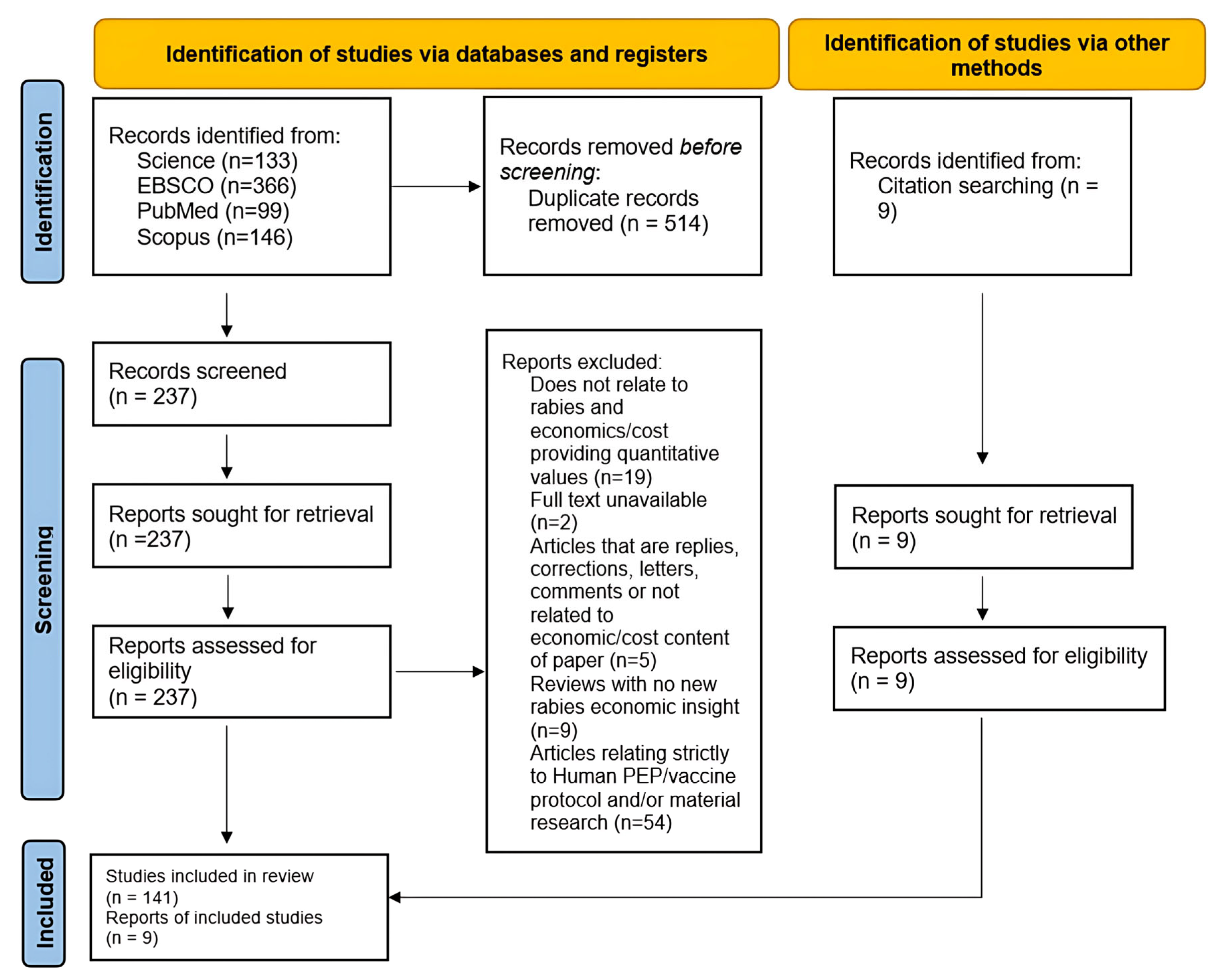
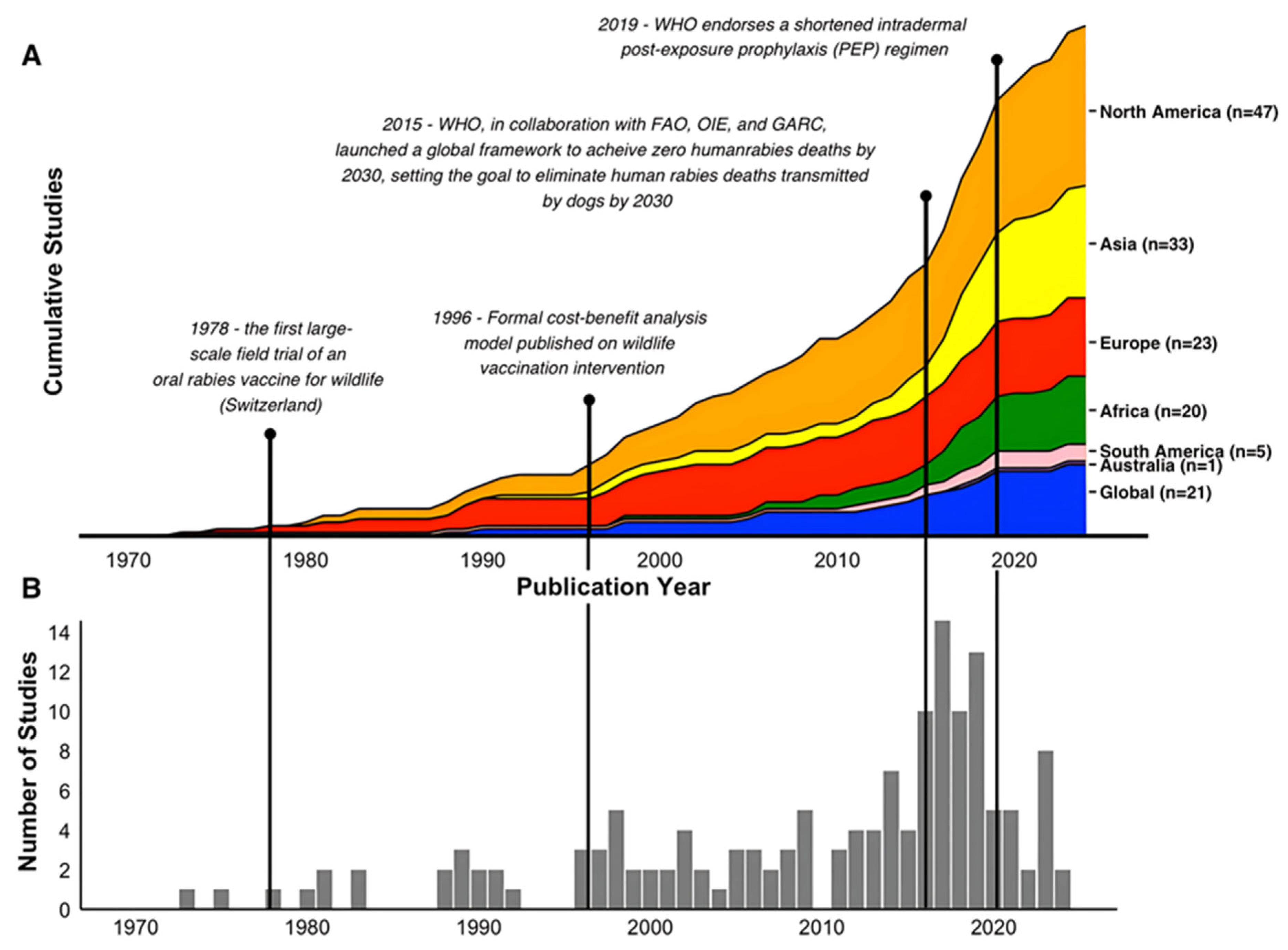
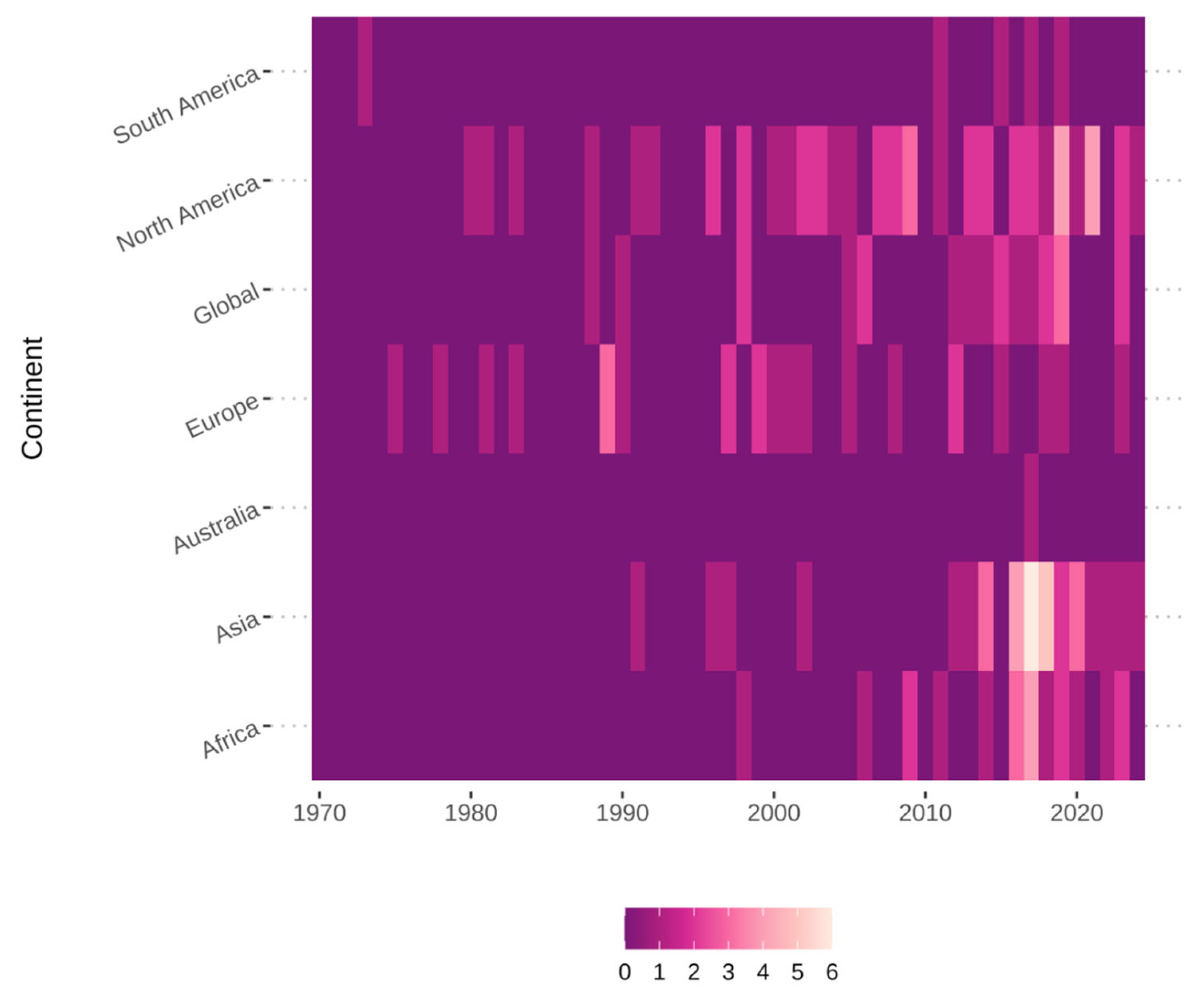
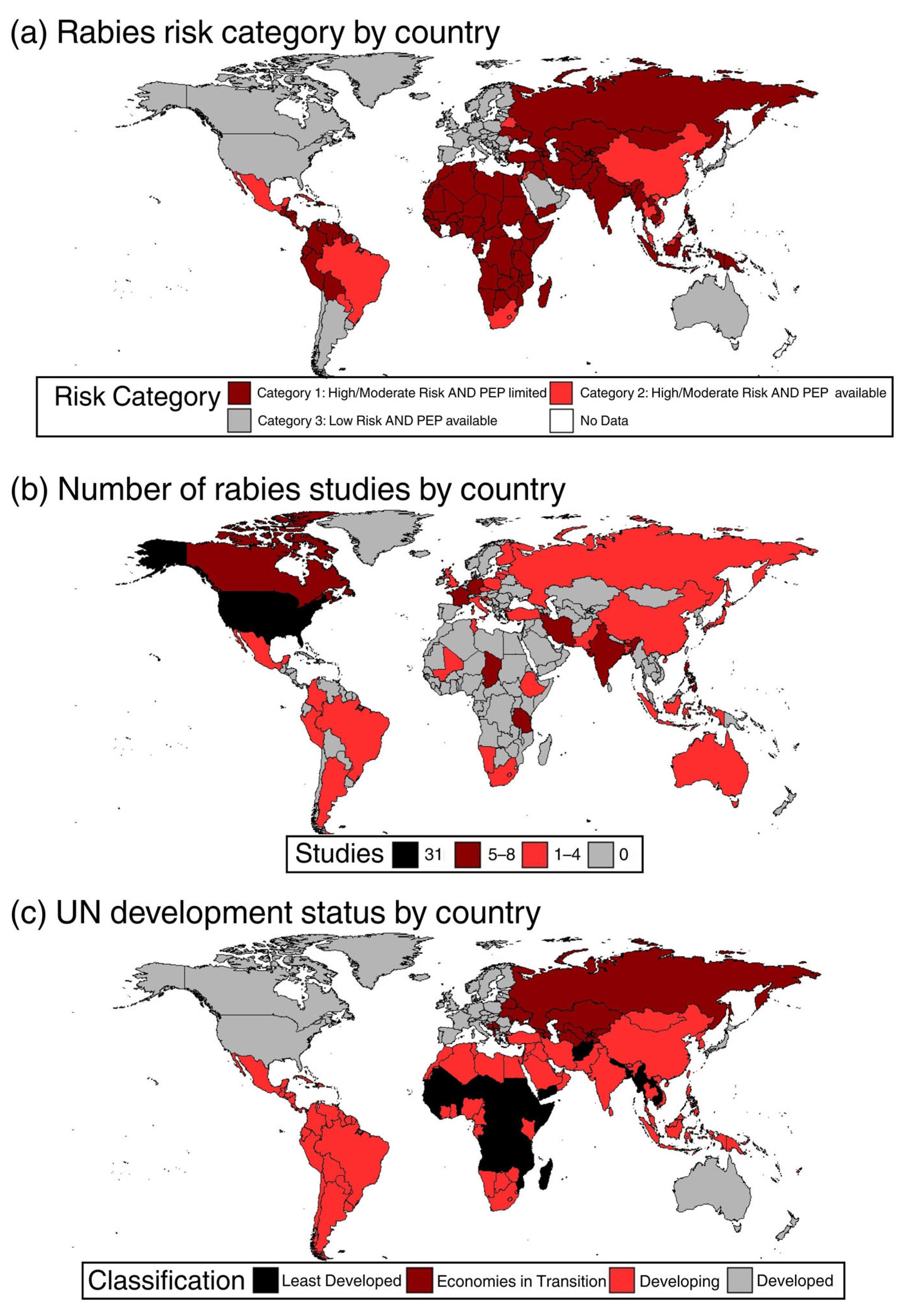
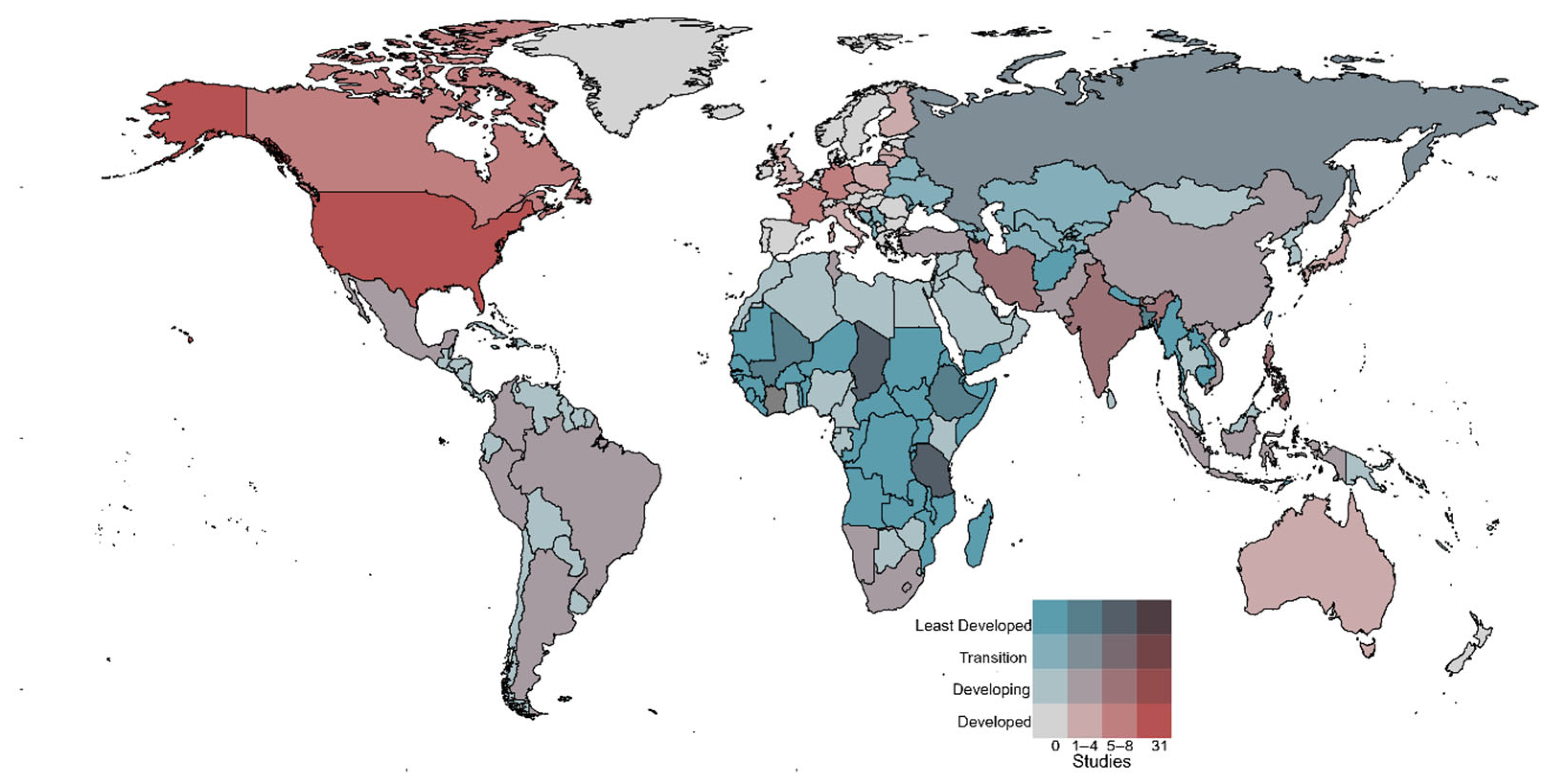
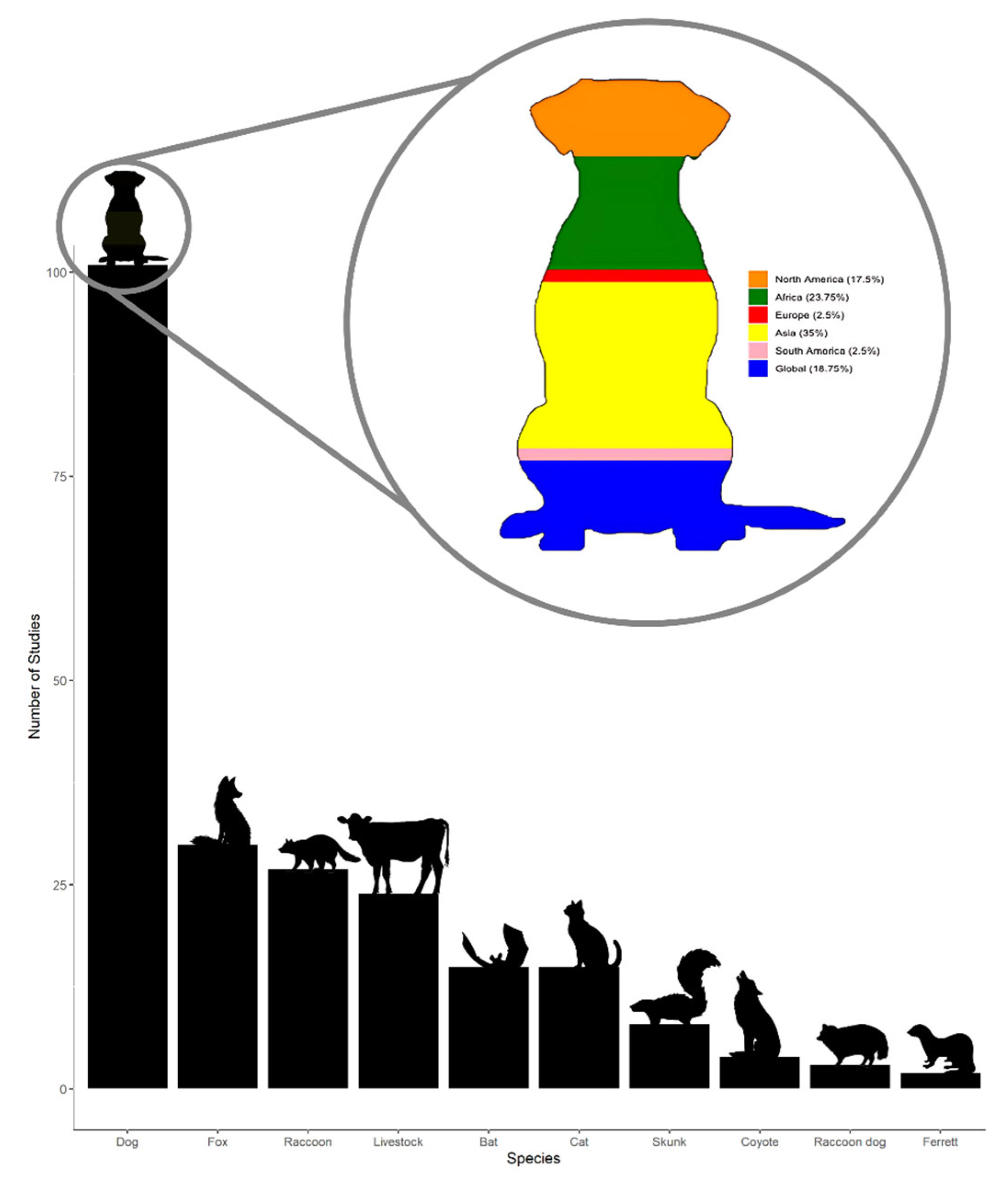
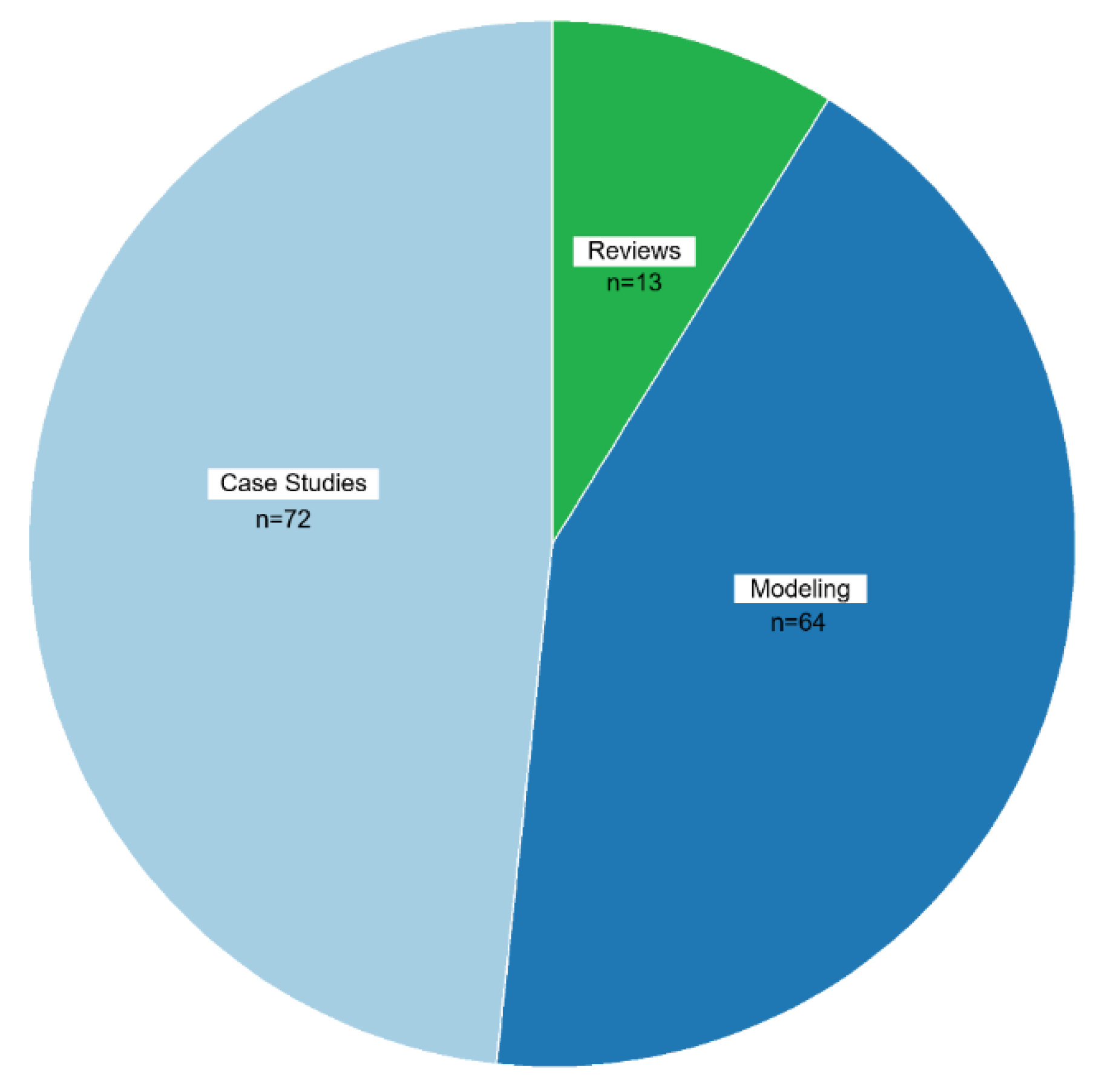
Disclaimer/Publisher’s Note: The statements, opinions and data contained in all publications are solely those of the individual author(s) and contributor(s) and not of MDPI and/or the editor(s). MDPI and/or the editor(s) disclaim responsibility for any injury to people or property resulting from any ideas, methods, instructions or products referred to in the content. |
© 2025 by the authors. Licensee MDPI, Basel, Switzerland. This article is an open access article distributed under the terms and conditions of the Creative Commons Attribution (CC BY) license (https://creativecommons.org/licenses/by/4.0/).
Share and Cite
Selleck, M.; Koppes, P.; Jareb, C.; Shwiff, S.; Liu, L.; Shwiff, S.A. The Economic Landscape of Global Rabies: A Scoping Review and Future Directions. Trop. Med. Infect. Dis. 2025, 10, 222. https://doi.org/10.3390/tropicalmed10080222
Selleck M, Koppes P, Jareb C, Shwiff S, Liu L, Shwiff SA. The Economic Landscape of Global Rabies: A Scoping Review and Future Directions. Tropical Medicine and Infectious Disease. 2025; 10(8):222. https://doi.org/10.3390/tropicalmed10080222
Chicago/Turabian StyleSelleck, Molly, Peter Koppes, Colin Jareb, Steven Shwiff, Lirong Liu, and Stephanie A. Shwiff. 2025. "The Economic Landscape of Global Rabies: A Scoping Review and Future Directions" Tropical Medicine and Infectious Disease 10, no. 8: 222. https://doi.org/10.3390/tropicalmed10080222
APA StyleSelleck, M., Koppes, P., Jareb, C., Shwiff, S., Liu, L., & Shwiff, S. A. (2025). The Economic Landscape of Global Rabies: A Scoping Review and Future Directions. Tropical Medicine and Infectious Disease, 10(8), 222. https://doi.org/10.3390/tropicalmed10080222







